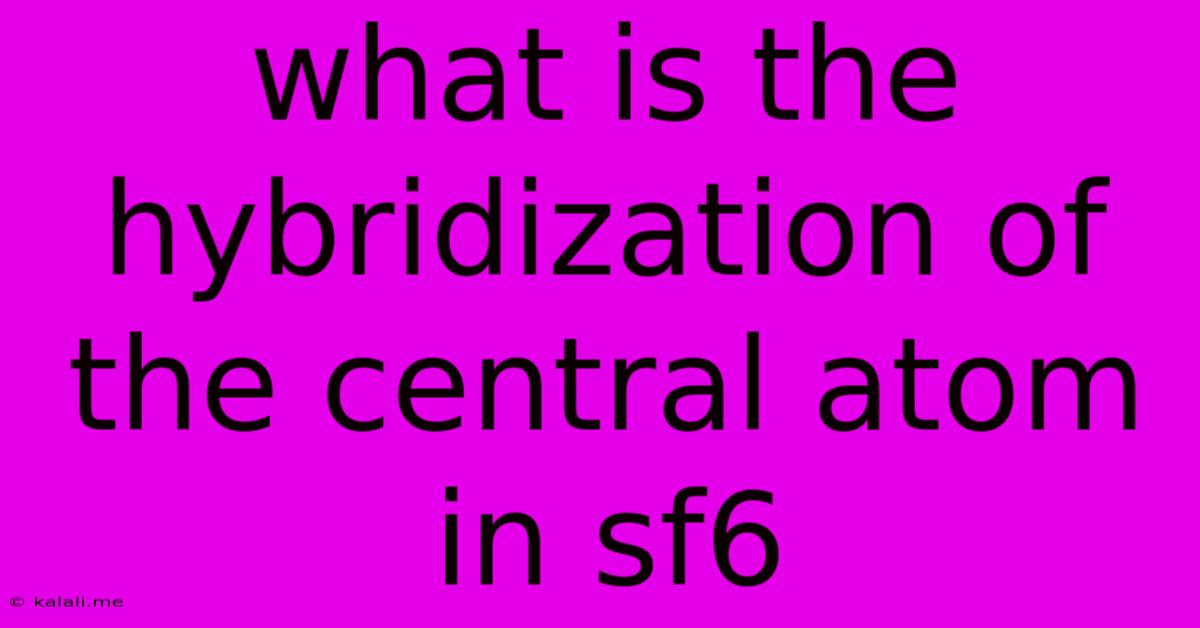What Is The Hybridization Of The Central Atom In Sf6
Kalali
Jun 15, 2025 · 2 min read

Table of Contents
What is the Hybridization of the Central Atom in SF₆?
The sulfur hexafluoride molecule (SF₆) is a fascinating example in chemistry, particularly when discussing molecular geometry and hybridization. Understanding its structure helps illustrate key concepts in bonding theory. This article will delve into the hybridization of the central sulfur atom in SF₆, explaining the process and its implications for the molecule's overall shape and properties.
Understanding Hybridization
Hybridization is a concept used in valence bond theory to explain the bonding in molecules. It involves the mixing of atomic orbitals within an atom to create new hybrid orbitals that are more suitable for bonding. These hybrid orbitals have different shapes and energies than the original atomic orbitals. The type of hybridization depends on the number of sigma (σ) bonds and lone pairs of electrons surrounding the central atom.
Determining the Hybridization of Sulfur in SF₆
To determine the hybridization of sulfur in SF₆, we follow these steps:
-
Determine the number of valence electrons: Sulfur (S) has 6 valence electrons, and each fluorine (F) atom has 7. Therefore, the total number of valence electrons in SF₆ is 6 + (6 x 7) = 48 electrons.
-
Draw the Lewis structure: The Lewis structure shows that sulfur is surrounded by six fluorine atoms, each bonded to it via a single covalent bond. This means sulfur forms six sigma (σ) bonds.
-
Count the number of sigma bonds and lone pairs: Sulfur in SF₆ has six sigma bonds and zero lone pairs.
-
Determine the hybridization: The general formula for determining hybridization is: Hybridization = (Number of sigma bonds) + (Number of lone pairs). In the case of SF₆, this is 6 + 0 = 6. A total of six hybrid orbitals are needed. This corresponds to sp³d² hybridization.
The sp³d² Hybridization and the Octahedral Geometry of SF₆
The sp³d² hybridization results in six equivalent hybrid orbitals arranged in an octahedral geometry. This means the six fluorine atoms are positioned at the corners of an octahedron, with the sulfur atom at the center. The octahedral geometry is highly symmetrical and contributes to the nonpolar nature of the SF₆ molecule despite the polar S-F bonds. This symmetry cancels out the individual bond dipoles.
Key Takeaways
- The central sulfur atom in SF₆ exhibits sp³d² hybridization.
- This hybridization leads to the formation of six equivalent hybrid orbitals.
- These orbitals form six sigma (σ) bonds with six fluorine atoms.
- The resulting molecular geometry is octahedral.
Understanding the hybridization of the central atom in molecules like SF₆ is crucial for predicting their shapes, properties, and reactivity. The sp³d² hybridization in this case perfectly explains the stable and symmetric structure of sulfur hexafluoride. The concept of hybridization is a fundamental tool in understanding molecular bonding and structure in various chemical compounds.
Latest Posts
Related Post
Thank you for visiting our website which covers about What Is The Hybridization Of The Central Atom In Sf6 . We hope the information provided has been useful to you. Feel free to contact us if you have any questions or need further assistance. See you next time and don't miss to bookmark.